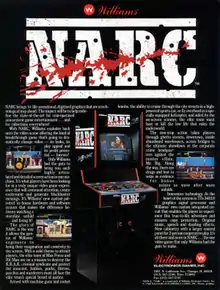Narc (video game)
Narc is a 1988 run and gun arcade game designed by Eugene Jarvis for Williams Electronics and programmed by George Petro.[1] It was one of the first ultra-violent video games and a frequent target of parental criticism of the video game industry. The object is to arrest and kill drug offenders, confiscate their money and drugs, and defeat "Mr. Big". It was the first game in the newly restarted Williams Electronics coin-op division, after being acquired by Midway.
| Narc | |
|---|---|
 Arcade flyer | |
| Developer(s) | Williams Electronics Rare (NES) |
| Publisher(s) | WMS Industries |
| Director(s) | Nathaniel Davies |
| Designer(s) | Eugene Jarvis |
| Programmer(s) | George N. Petro |
| Composer(s) | Brian L. Schmidt Marc LoCascio ("NARC Rap") David Wise (NES) Tony Williams (Amiga/ST) |
| Platform(s) | Arcade, Amiga, Atari ST, Amstrad CPC, Commodore 64, ZX Spectrum, NES |
| Release | Arcade 1988 |
| Genre(s) | Run and gun |
| Mode(s) | Up to 2 players simultaneously |
| Arcade system | Williams Z-Unit |
Narc was ported to the Commodore 64, Atari ST, Amiga, ZX Spectrum, Amstrad CPC, and NES. In 2005, the franchise was re-launched with a new game for the Xbox and PS2.
Gameplay
.png.webp)
The game's main characters are Max Force and Hit Man, who have received a memo from Spencer Williams, Narcotics Opposition chairman in Washington, D.C. dispatching them on Project NARC. Their mission is to apprehend Mr. Big, head of an underground drug trafficking and terrorist organization.
The player controls either Max Force or Hit Man, who shoot or arrest junkies, drug dealers, and organized crime kingpins. Max and Hit are each equipped with an automatic weapon and a missile launcher. When an enemy is dispatched using the latter, they explode in a torrent of scorched and bloody appendages. Some enemies can be arrested after they surrender and then float away with "busted" over them. This is then added to a tally at the end of the level along with drugs and money confiscated from other enemies that they dropped when gunned down (the game awards more points at the end of a round for arresting enemies without killing them).
Technical details
The arcade game uses what is termed a "medium resolution monitor": higher resolution than televisions and normal arcade monitors, but in a smaller physical size.
Narc is the first arcade game to use the Texas Instruments TMS34010, a 32-bit processor with graphics-oriented instructions built-in. It was later used in Smash TV, Mortal Kombat, and NBA Jam.
Ports
The 1990 Nintendo Entertainment System (NES) version of NARC, published by Acclaim Entertainment and developed by Rare was billed as "the first video game with a strong anti-drug message,"[2] though Nintendo forced all drug references to be removed from the actual gameplay. The game retained most of its violence and gore.
Most of the computer ports had their music ported by Tony Williams, credited as "Sound Images" and David Wise ported the arcade music to the NES. The Game Boy version of Terminator 2: Judgment Day uses some music from NARC.
Reception
All the versions of the game generally received positive reviews , being praised for its intense action and enjoyable gameplay, but criticism for its repetiveness, including 9/10 from CRASH, 8/10 from Sinclair User and 72% from Your Sinclair. Matt Bielby of Your Sinclair called it "one of the most objectionable Speccy games I've seen in ages", and called it "repetitive" and the plot "utter nonsense."[3] However, due to being one of the first games to feature blood, it has been a target of concerns and criticism from parents.
Legacy
In 1990, Acclaim released NARC as a handheld LCD game.
The main musical theme by Brian L. Schmidt was recorded by the band Pixies and released as a B-side to their "Planet of Sound" single in 1990.[4]
Max Force and Mr. Big appeared as characters in the cartoon The Power Team and in the film 22 Jump Street.
NARC is included in the Midway Arcade Treasures 2(2004) collection.
2005 game
A 2005 update was developed by VIS Entertainment and published by Midway Games for the Xbox, PlayStation 2, and Microsoft Windows. The Windows version, only released in Europe, was developed by Point of View.
The game casts the players as narcotics officer Jack Forzenski and DEA agent Marcus Hill, former partners reunited who are instructed to investigate a new drug on the streets called Liquid Soul. After arresting dealers and confiscating their stock, the player can either take the confiscated items to the evidence room, or keep them for future use. This confers benefits such as improved weapons accuracy. Dealing drugs for financial benefit is also possible.
A March 21, 2005 press release announced the game's shipment to retailers and emphasized that NARC was designed for an "older audience".[5] The game was given an M rating.
Footnotes
- "NARC". The International Arcade Museum. Retrieved 6 Oct 2013.
- "NES Instruction Manuals: NARC". World-of-nintendo.com. 1997-01-17. Retrieved 2012-09-20.
- "NARC". Ysrnry.co.uk. Archived from the original on 2012-03-26. Retrieved 2012-09-20.
- "Archived copy". Archived from the original on 2015-05-20. Retrieved 2019-01-07.CS1 maint: archived copy as title (link)
- "Midway Ships NARC for the Xbox". Archived from the original on 2008-11-20.
References
- Citing 'Narc,' Ill. Gov. Seeks Video-Game Sales Ban, Mar. 22, 2005.
- Johnson, Eric (a.k.a. VegitaBOD): NARC Walkthrough/FAQ.
- Midway Ships NARC for the Xbox, Xbox News, Mar. 21, 2005.
- Morris, Chris: Weed, speed and LSD – in a video game?, Mar. 12, 2004.
- NARC; God of War; Heritage of Kings: The Settlers, The Washington Post, Mar. 27, 2005.
- Pepin, Chris: NARC NES manual.
External links
- NARC at the Killer List of Videogames
- Narc on Coinop.org
- Soundtrack Info
- PC Game Source
- Narc (2005) at IMDb